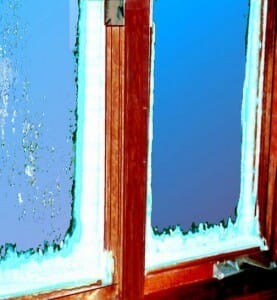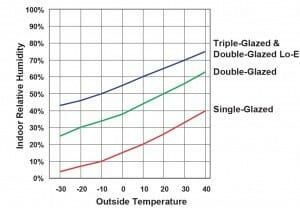

Often the Key to Wintertime Moisture Problems is Ventilation


Wintertime moisture problems use to mean overly dry air that required adding humidity. This is changing with the construction of tightly built, energy-efficient new homes and energy upgrades in older homes. These homes may experience wintertime problems caused by excessive humidity. The most common symptoms of excessive humidity are condensation or “fog” forming on the window glass.
The underlying reason for this humidity build-up is the reduced amount of outdoor air circulation through the structure.
This air leakage is called natural ventilation. The amount of natural ventilation may be sufficient to provide acceptable air quality but not enough to correct the moisture problem. Conversely, a moisture problem may not exist in a home that requires additional fresh air for acceptable indoor air quality. Cold weather building scientists all agree that the healthiest, most energy-efficient home is built “tight” with mechanical ventilation to assure indoor air quality and moisture control.
The wintertime humidity level present in a home is the difference between the indoor moisture load and the natural ventilation rate’s ability to remove it.
Generally, “leaky” homes have high natural ventilation rates and low indoor moisture levels. “Tight” homes have low natural ventilation rates and high indoor moisture levels. The humidity levels can become high enough in “tight” homes that condensation will form on cold surfaces. In nearly all cases, the edges of the window glass are the coldest surface and moisture condenses there. Curtains, drapes and window blinds will insulate the indoor surfaces of windows from the homes heat. This causes the window surfaces to be even colder. In some homes, moisture will also condense on cold spots of outside walls and ceilings.
The chart below shows the conditions when condensation will form at the center of the window glass when the indoor temperature is 70 degrees.
Remember, the center is the warmest part of the glass. The edges of the glass can be 10 to 15 degrees cooler than the center.
The most cost-effective way to solve wintertime moisture problems and assure proper indoor air quality is to use some type of mechanical ventilation system.


The spot ventilation provided by the occasional use of bath fans and range hoods is not sufficient to remove the high humidity found in most tightly constructed or remodeled homes. An Ultra-Aire whole house ventilating dehumidifier will provide mechanical fresh air based on a timed occupancy schedule and may be the best choice for addressing your winter moisture problems. During the months that you do not need dedicated moisture control in the entire home, the units will supply the right amount of fresh dry air to help control high indoor relative humidity issue.
Published on Feb 05 2015
Last Updated on Jan 14 2020